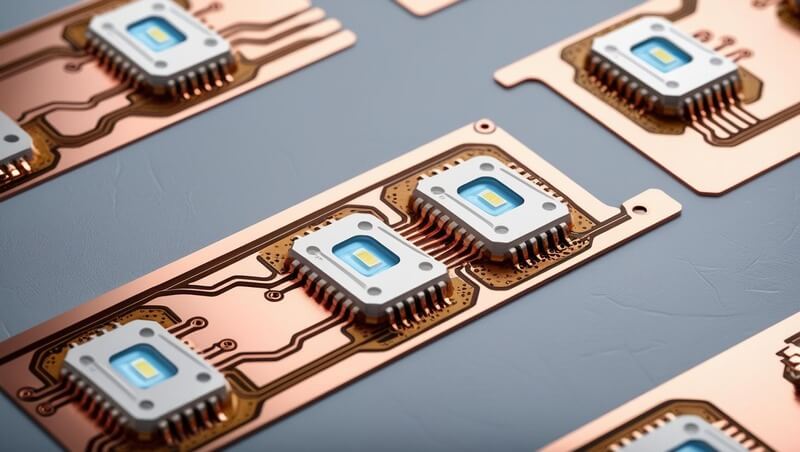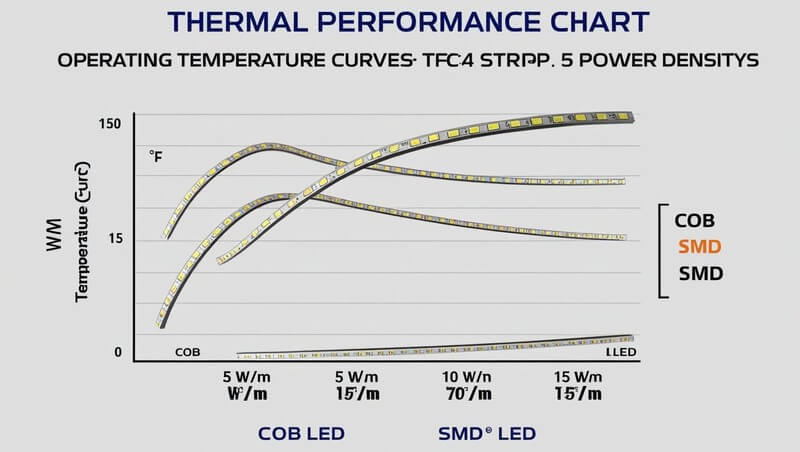Vous avez besoin d'un produit de qualité en peu de temps ? Nous avons un plan pour vous.



A Bande LED COB uses a “chip-on-board” process, bonding bare LED die directly onto a flexible PCB substrate without individual plastic housings. By eliminating separate SMD packages, manufacturers achieve extremely high emitter density—often 200 or more LEDs per metre—resulting in a continuous, ribbon-like glow rather than discrete points of light.
In place of individual LEDs, COB strips employ a uniform phosphor layer over the densely packed die. This coating diffuses the combined light output, smoothing spectral spikes and improving color consistency across the strip’s length. Most COB constructions use flexible copper-clad PCB with an optional aluminium heat-spreader backing to enhance thermal performance for high-wattage applications.
Because the LED chips sit directly on the board, heat travels efficiently from the die into the PCB and any attached heatsink. This direct thermal path reduces junction temperatures under load, extending the strip’s lifespan. COB strips excel in installations that demand glare-free illumination—architectural coves, retail showcases, and dynamic signage where visual uniformity is critical.
In a COB strip, individual LED die are bonded directly onto a copper-clad flexible PCB, eliminating the need for separate SMD packages. After the bare LED chips are placed in precise locations, tiny wire bonds connect each die to copper traces. A thin layer of transparent epoxy or silicone then encapsulates the die and wires, sealing them against moisture and mechanical stress. This direct-bond construction minimizes parts count and simplifies assembly, reducing manufacturing cost per lumen.

Next, a phosphor coating—often dispensed in liquid form—covers the clustered die. As blue or UV light from the bare chips excites the phosphor, it re-emits across a broader spectrum, smoothing out color peaks and improving CRI. The phosphor thickness and composition are tuned to achieve the desired white point or color temperature. Unlike multi-LED strips that rely solely on discrete color mixing, the phosphor layer in COB strips blends light more uniformly, giving a smooth, even glow without visible color shifts.
Thermally, COB technology offers a direct heat path: heat generated by the LEDs travels straight through the die into the PCB’s copper layer and any attached heatsink or aluminium backing. This efficient thermal conduction keeps junction temperatures lower than in conventional SMD configurations, where heat must pass through the LED package first. The result is improved reliability and longer rated life, even at higher drive currents. In practice, I’ve observed COB strips running 5 °C to 10 °C cooler at the same wattage, reducing the need for bulky heat-sink profiles.
COB strips deliver a seamless, ribbon-like glow by packing bare LED die directly onto the PCB. With no discrete LED packages, you see no individual hotspots—just a uniform line of light. The integrated phosphor coating further smooths color output and raises CRI, making COB ideal where visual consistency matters.
Key Benefits
Despite a 20 %–30 % higher upfront cost, COB strips often outlast SMD alternatives thanks to superior heat dissipation and fewer packaging materials. Their high-density form factor also enables slimmer, more flexible installations in coves, under cabinets, and behind signage—applications where hiding discrete LEDs isn’t possible.
🧾 T1 — COB vs SMD Feature Comparison
| Feature | COB Strip | SMD Strip |
| Light Uniformity | Seamless, hotspot-free | Visible individual LEDs |
| Emitter Density | ≥ 200 LEDs/m | 30–60 LEDs/m |
| Thermal Path | Direct into PCB | Through LED package |
| Diffusing Requirements | Minimal lens or cover | Thick silicone or polycarbonate |
| Cost per Metre | 20 %–30 % higher | Lower entry price |

Bandes LED COB run hotter than their SMD counterparts because densely packed die concentrate heat over a smaller area. Without proper heatsinking, surface temperatures can exceed safe thresholds, potentially reducing lifespan or causing phosphor degradation. Always factor in thermal management when specifying COB strips for high-output applications.
Because COB die sit directly on the PCB, heat must flow through the board and any attached heatsink. In tests, COB strips can run 5 °C–10 °C hotter than equivalent SMD strips at the same wattage if mounted on plain plastic. Using aluminium profiles or dedicated heat-sink channels is essential; without them, junction temperatures may exceed the strip’s rated maximum, accelerating lumen depreciation.
Another drawback is cost: COB manufacturing involves additional phosphor processing and precision die-bonding, which adds 20 %–30 % to the strip’s price compared to SMD. For budget-sensitive projects, this premium may outweigh the benefits of uniform light, so weigh the trade-off according to application needs.
Additionally, COB strips often offer fewer color-temperature and RGBW variants than standard SMD lines. Many COB products focus on white-light applications (CCT 2700 K–6500 K) with limited RGB or RGBW options. If you require specialized hues or dynamic color effects, verify that your chosen COB series supports those features before purchase.
Finally, COB strips have fewer cutting points—commonly every 50 mm instead of 25 mm—due to the continuous emitter layout. This can limit installation flexibility in tight spaces or intricate designs. Plan your runs carefully or opt for longer flexible segments where precise cuts aren’t critical.
Below is a quick overview of the key advantages and drawbacks to help you decide if COB strips suit your project needs.
🧾 T2 — COB Pros & Cons Breakdown
| Aspect | Pour | Cons |
| Qualité | Uniform, hotspot-free illumination | Higher upfront cost |
| Efficiency | Direct thermal path for longer life | Requires robust heatsinking |
| Installation | Minimal diffuser/lens needed | Fewer cutting points per metre |
| Flexibilité | High-density form factor for tight spaces | Limited color-temperature and RGBW options |
COB LED strips shine where uniform, glare-free illumination is essential. Their seamless output and high density make them ideal for both aesthetic and functional installations.

Typical Use Cases:
Is COB LED technology better than traditional LED strips?
COB strips deliver seamless, hotspot-free illumination with high emitter density and efficient heat dissipation, making them ideal for glare-free installs. Traditional SMD strips cost less, offer more cutting points, and wider color options. Choose COB when uniform light and thermal performance outweigh budget and flexibility concerns.
What are the main disadvantages of COB LED strips?
COB strips carry a 20 %–30 % cost premium over SMD alternatives and require robust heatsinking due to higher surface temperatures. They also offer fewer cut-point intervals (often every 50 mm) and limited color-temperature or RGBW variants, which may restrict installation flexibility and customization.
Do COB LED strips run hotter than SMD strips?
Yes. Because COB die are densely packed, surface temperatures can run 5 °C–10 °C higher than equivalent SMD strips at the same wattage if not properly heatsinked. Mount COB strips in aluminium channels or heat-sink profiles to maintain safe operating temperatures and maximize lifespan.
What is the difference between COB and normal LED strips?
COB strips bond bare LED die directly to the PCB, creating a continuous light ribbon with minimal diffusion. Standard strips use discrete SMD packages (30–60 LEDs/m) that produce visible points of light and require diffusers. COB offers ≥ 200 LEDs/m, uniform output, and a direct thermal path, while SMD is cheaper and more modular.
COB LED strips offer unmatched uniformity and efficiency by mounting bare LED die directly onto a PCB, resulting in a seamless glow and superior thermal performance. While they come at a modest cost premium and require careful heatsinking, their high emitter density and minimal diffusion make them perfect for architectural coves, retail displays, and custom signage.
For detailed specifications and to explore our full range, visit our COB LED Strip collection. To understand installation best practices, download the DOE Solid-State Lighting Fact Sheet 2024.